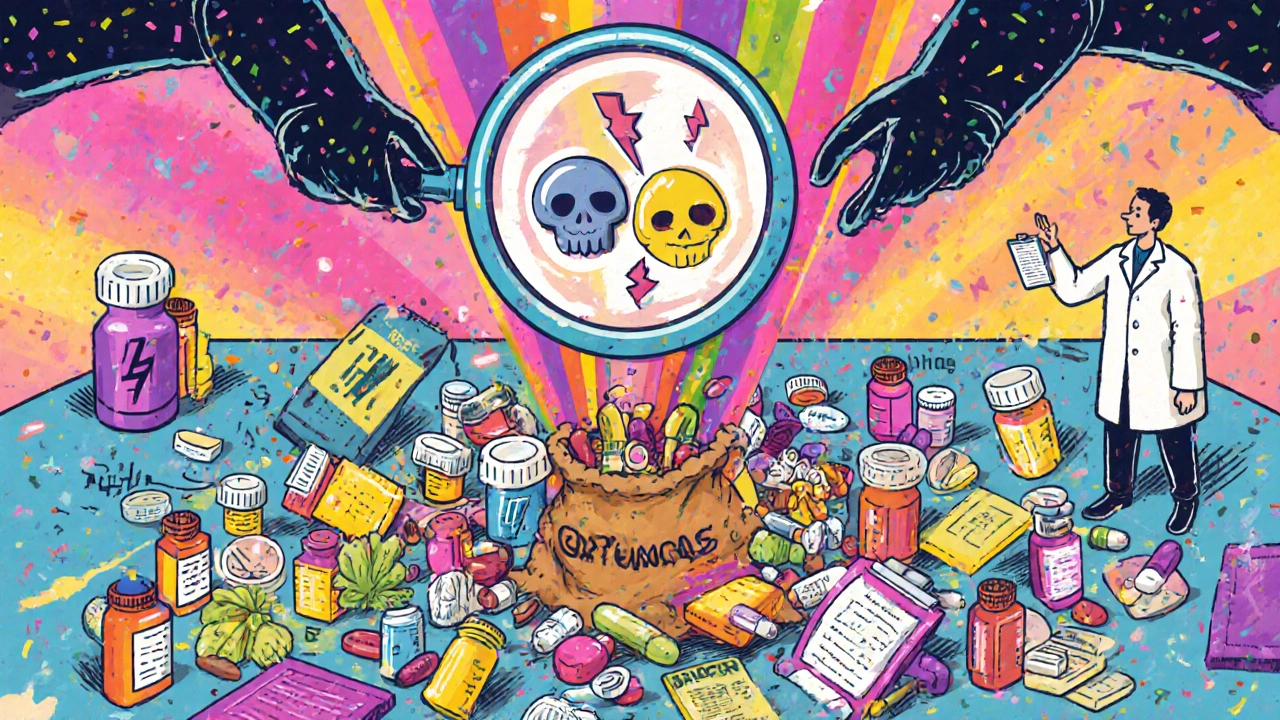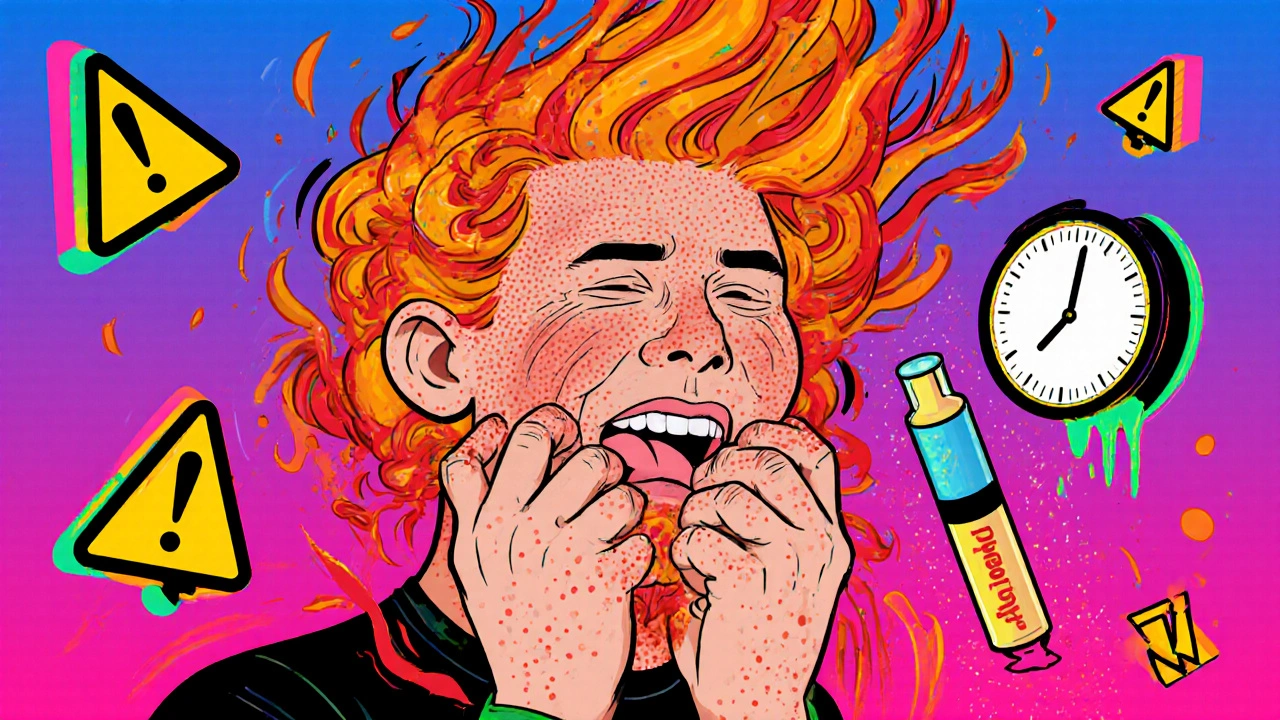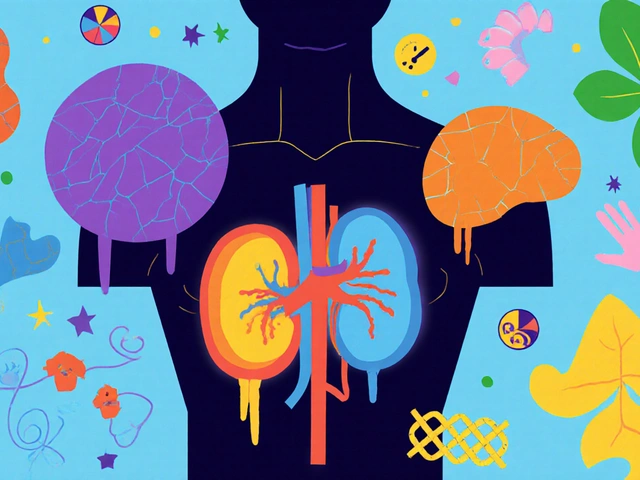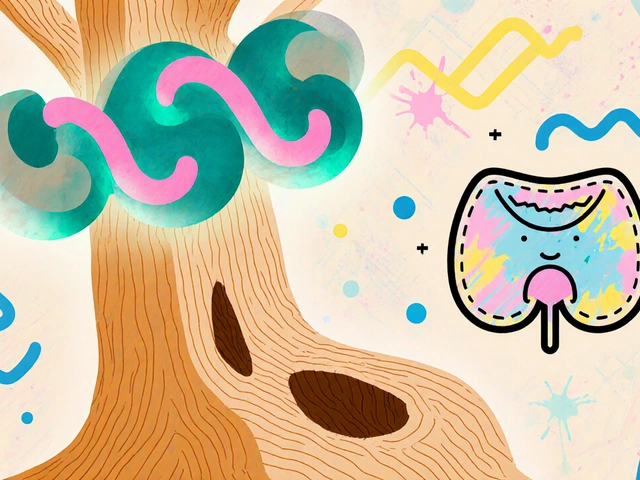When you take a new medication, you expect relief - not a hidden danger. Most side effects are mild: a dry mouth, a little drowsiness, maybe an upset stomach. But some reactions can turn deadly in hours. The difference between a nuisance and a medical emergency often comes down to recognizing the early signs before it’s too late.
What Makes a Side Effect Dangerous?
Not all side effects are created equal. The FDA defines a serious adverse drug reaction as one that leads to death, hospitalization, disability, permanent damage, or a birth defect. These aren’t rare. In 2022, over 1.3 million people in the U.S. ended up in the emergency room because of medication side effects. About 128,000 died. Many of these cases could have been prevented if the warning signs had been caught early. The real risk isn’t just the drug itself - it’s how your body reacts to it. Some reactions happen fast, within minutes. Others creep in over days. Either way, if you’re not watching for the red flags, you could miss the window to act.Life-Threatening Symptoms: The Immediate Red Flags
If you take a pill and suddenly feel like something is very wrong, don’t wait. These symptoms need emergency care right away:- Difficulty breathing - Feeling like you can’t get enough air, wheezing, or tightness in your throat.
- Swelling - Especially in your face, lips, tongue, or throat. This can block your airway.
- Hives or rash - Raised, red, itchy welts that appear quickly after taking the medication.
- Chest pain or irregular heartbeat - A heart rate over 100 beats per minute, fluttering, pounding, or pain radiating to your arm or jaw.
- Seizures or convulsions - Uncontrolled shaking, loss of awareness, or staring spells.
- Severe vomiting or blood in stool - This could mean internal bleeding or organ damage.
Hidden Dangers: Symptoms That Sneak Up
Some of the most dangerous side effects don’t scream for attention. They whisper. And by the time you notice, the damage is done.- Yellowing skin or eyes (jaundice) - This isn’t just a sign of being tired. It means your liver is struggling. Medications like semaglutide (Ozempic), methotrexate, or even some antibiotics can cause liver injury. When combined with severe stomach pain, it’s a red flag for pancreatitis - a condition that can kill within 24 to 48 hours if untreated.
- Unusual bleeding or bruising - If you’re brushing your teeth and your gums bleed nonstop, or you wake up with purple spots on your skin, it could mean your blood isn’t clotting. This happens with blood thinners, some antibiotics, or even high doses of NSAIDs.
- Extreme fatigue with swelling - Feeling constantly worn out, plus puffy legs or a swollen belly? This could be kidney failure or drug-induced anemia. Your kidneys filter toxins. If they’re failing, fluid builds up, and your body can’t make enough red blood cells.
- Confusion or extreme drowsiness - If you’re on opioids, benzodiazepines, or sleep meds, and you’re sleeping more than usual, can’t wake up, or are acting disoriented, you could be slipping into central nervous system depression. This slows your breathing. It can stop it.
- Decreased urine output - Going from peeing 6 times a day to only once or twice? That’s not normal. It’s a sign your kidneys are shutting down. This can happen with NSAIDs, certain antibiotics, or even too much of a blood pressure pill.
Who’s at Highest Risk?
Some people are more likely to have dangerous reactions. Age is a big factor. People over 65 are 2.7 times more likely to suffer serious side effects than younger adults. Why? Their bodies process drugs slower. Their kidneys and liver don’t work as well. And many are taking five or more medications at once - a situation called polypharmacy. Polypharmacy increases the risk of dangerous interactions by 300%. A common example? Taking an NSAID like ibuprofen with a blood thinner like warfarin. Together, they can cause internal bleeding. Or mixing certain antidepressants with migraine meds - that can trigger serotonin syndrome, a condition that causes fever, muscle rigidity, and seizures. Another hidden risk? Look-alike, sound-alike drugs. Insulin and heparin are two of the most commonly confused medications. Mix them up, and you could overdose on a blood thinner or inject pure sugar into your vein. The Institute for Safe Medication Practices says these errors cause 12% of all dangerous side effects.What to Do When You Notice Something Wrong
Don’t panic. But don’t ignore it either. Here’s what to do based on the symptoms:- Emergency symptoms (breathing trouble, swelling, chest pain, seizures): Call 911 immediately. If you have an epinephrine auto-injector (like an EpiPen), use it now.
- Warning signs (jaundice, unusual bleeding, confusion, no urine output): Call your doctor or pharmacist within the next 24 hours. Don’t wait until your next appointment.
- Any new symptom you didn’t have before starting the drug: Write it down. Note when it started, how bad it is, and if anything makes it better or worse. Bring this list to your next visit.

How to Protect Yourself
Prevention is your best defense. Here’s how:- Use the Brown Bag Method. Every few months, gather all your medications - pills, patches, vitamins, supplements - and bring them to your doctor. You’d be surprised how many people are taking something that interacts dangerously with another drug.
- Know your meds. Ask your pharmacist: “What are the top three dangerous side effects I should watch for with this drug?” Don’t just rely on the leaflet.
- Track changes. Pay attention to your body. New dizziness? Unexplained weight gain? A rash that won’t go away? These aren’t just inconveniences - they’re signals.
- Ask about genetic testing. If you’re prescribed a high-risk drug like carbamazepine (for seizures) or abacavir (for HIV), ask if genetic screening is available. Testing for the HLA-B*15:02 gene can prevent a deadly skin reaction in some people.
Final Thought: Trust Your Instincts
You know your body better than anyone. If something feels off after taking a new medication, it probably is. Don’t dismiss it as “just a side effect.” Don’t assume it’s “normal.” Don’t wait to see if it gets better. The most dangerous side effects don’t announce themselves with sirens. They whisper. And if you’re not listening, you might miss the warning before it’s too late.Can medication side effects happen weeks after starting a drug?
Yes. While some reactions like allergic rashes or anaphylaxis happen within minutes to hours, others - like liver damage, kidney problems, or drug-induced anemia - can take days, weeks, or even months to appear. Medications like statins, antibiotics, or seizure drugs are known to cause delayed reactions. Always monitor your health after starting a new prescription, even if you feel fine at first.
What should I do if I think I’m having a bad reaction but I’m not sure it’s serious?
Call your doctor or pharmacist. Don’t wait. Even if you’re unsure, describe exactly what you’re feeling - the timing, the intensity, and whether it’s getting worse. Many dangerous reactions start mildly. A pharmacist can tell you if your symptoms match known risks for that drug. If in doubt, err on the side of caution.
Are over-the-counter meds like ibuprofen or Tylenol safe?
They’re generally safe at recommended doses, but they can still cause serious harm. Long-term use of ibuprofen can lead to stomach bleeding or kidney damage. Too much Tylenol (acetaminophen) can cause sudden, life-threatening liver failure - even if you don’t drink alcohol. Never exceed the daily limit on the label, and don’t combine multiple products that contain the same active ingredient.
Can supplements and herbal remedies cause dangerous side effects?
Absolutely. St. John’s Wort can interfere with antidepressants, birth control, and blood thinners. Garlic and ginkgo can increase bleeding risk, especially before surgery. Kava can damage the liver. Many people assume “natural” means safe, but herbs can be just as potent - and dangerous - as prescription drugs. Always tell your doctor what supplements you’re taking.
How do I know if my symptoms are from my medication or something else?
Track the timeline. Did the symptom start within hours or days of taking the drug? Did it get worse after each dose? Did it improve after stopping? That’s a strong clue. Also, if you’ve never had the symptom before - like sudden dizziness, rash, or swelling - and it appeared after starting a new medication, the link is likely real. Your doctor can help confirm it.
Is it safe to take medication if I’m pregnant or breastfeeding?
Some medications are safe, others aren’t. Even common drugs like ibuprofen or certain antibiotics can harm a developing baby or pass into breast milk. Always consult your doctor before taking any drug during pregnancy or while breastfeeding. The FDA has pregnancy risk categories, but the best advice is to use only what’s absolutely necessary and under medical supervision.
What should I do if I miss a dose and then feel worse?
Don’t double up. Missing a dose can cause withdrawal symptoms or rebound effects - especially with blood pressure meds, antidepressants, or seizure drugs. If you miss a dose, check the label or call your pharmacist. If you feel unwell after missing a dose, contact your doctor. Sudden changes in how you feel can signal a dangerous reaction or worsening condition.



November 15, 2025 AT 18:20 PM
Great breakdown of the red flags. I’ve seen too many people brush off rashes or fatigue as ‘just side effects’ until it’s too late. I’m from India, and here, people often self-medicate or skip follow-ups because of cost or access. This kind of info could save lives if shared widely.
Just remember - if your body says ‘no,’ listen. It’s not being dramatic. It’s trying to tell you something.